There are so many ways to weave Flocabulary into your classroom, and the popularity of hip-hop is just one reason to consider it. Cognitive neuroscience shows us that music has far-reaching effects on our brains. Music can engage us cognitively, behaviorally, and emotionally. Musical experiences can improve our brains’ neuroplasticity, decrease stress, increase focus, and create more vivid and lasting memories. Listening to or playing music activates both the left and right hemispheres of the brain, thereby affecting students’ auditory and motor skills, improving reading scores, and enhancing social-emotional skills such as emotional regulation. Music truly speaks to whole-child development, plus it’s a wonderfully engaging tool for teachers to use in the classroom.
Hip-hop music in particular is well suited for learning experiences. With more unique words than any other musical genre, hip-hop is a great way to put content to rhyme and rhythm and reinforce vocabulary and key concepts. Furthermore, hip-hop is extremely popular. Originating in the 1970s in the South Bronx, hip-hop is now an expansive and inclusive genre and is considered a part of global youth culture.
Here’s an example of the type of engaging videos you can find on Flocabulary!
What is Flocabulary?
Wrapped in the power of hip-hop combined with storytelling, art, humor, drama, and poetry, Flocabulary’s video-based lessons combine rigor and rhythm to help students make connections to their learning. Flocabulary has capitalized on such learning benefits by combining inclusive content with emotional connections through music. Fueled by these connections, students’ brains are more equipped with the vulnerability required to learn (Hammond). The videos are authentically engaging and designed to create unique and rich multimedia experiences for students; they’re created by professional illustrators and animators and written and recorded by professional lyricists and rappers.
New to Flocabulary? Teachers can sign up for a trial to access our lesson videos and assessment activities. Administrators can get in touch with us to learn more about unlocking the full power of Flocabulary through Flocabulary Plus.
10 Ways to use Flocabulary in the classroom
1. Use videos as a hook
One of the most straightforward ways to share the magic of Flocabulary is to share the video with your entire class as a co-viewing experience. Flocabulary videos work wonderfully as a lesson hook or anticipatory set to activate students’ prior knowledge.
First, adjust the pace of the video; you can slow it down as needed for student comprehension. After watching it through once, turn on the Discuss Mode toggle and watch the video a second time. During this viewing, the video will pause at strategic points to raise discussion questions. You can guide your class in a whole-group conversation or have students “think-pair-share” or “turn and talk” with their neighbors as a way to kick off your lesson content.
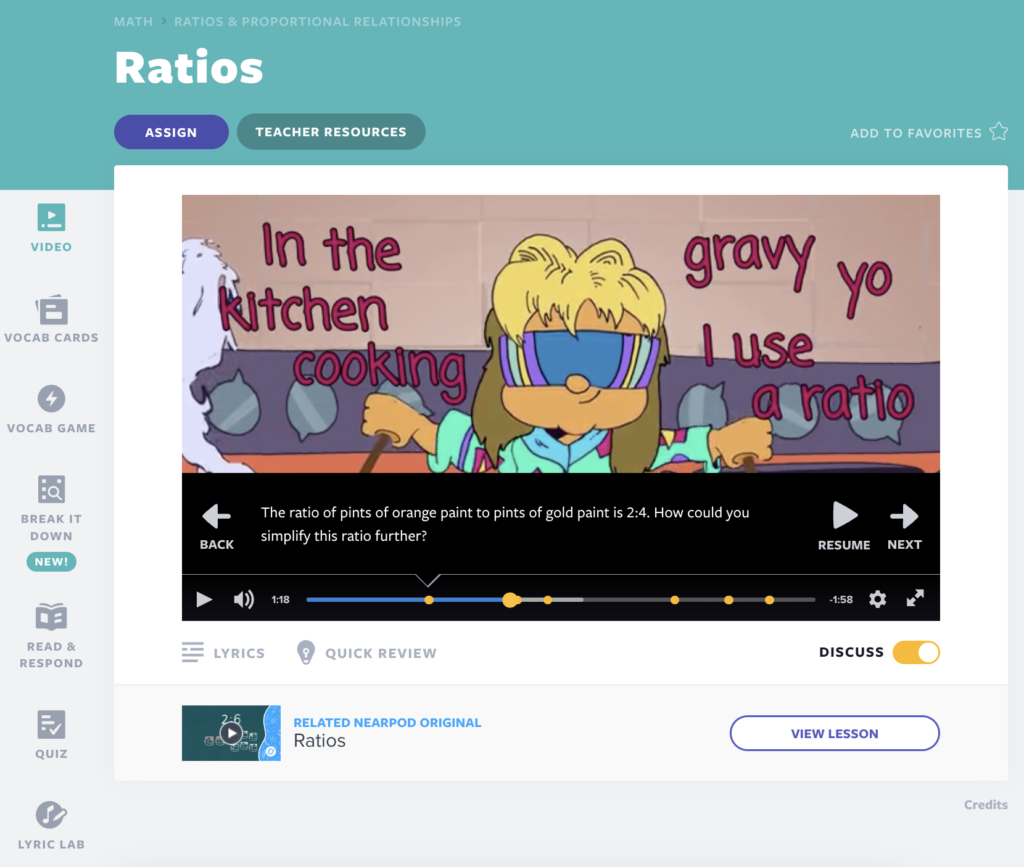
2. Bring in some gamification
Each Flocabulary lesson includes an engaging Vocab Game, in which students complete vocabulary questions. Correct answers build a hip-hop beat as they earn new sounds and instruments. This interactive and entertaining game brings a new dynamic to introducing or reviewing key lesson vocabulary. You may want to ask your students to raise their hands to answer the matching questions—or better yet, challenge them to get out of their seats and use the class smartboard to drag and drop the match in place. When students get all the questions correct—answering questions on definitions, synonyms, antonyms, lyrics, images, and fill-in-the-blanks—they build a full beat. There are 43 different beats to unlock. Music can make for a powerful mnemonic device!
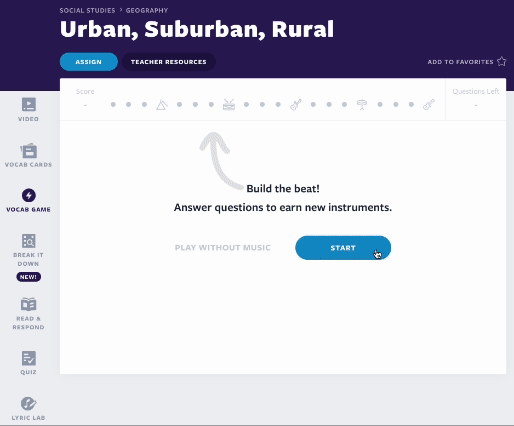
3. Get creative!
Flocabulary’s Lyric Lab is one of students’ favorite activities to complete. Lyric Lab is a scaffolded tool with which students can write their own academic rhymes or raps. As you wrap up a lesson or unit, consider how Lyric Lab can act as your culminating activity. You may want to challenge your students to create a collective rap or poem. We recommend watching our Hip-Hop Fundamentals video to teach students valuable hip-hop history to avoid perpetuating stereotypes, along with tips for writing raps.
First, prewrite the first line of a Lyric Lab lesson for students. Ask your students to think of ONE word that rhymes with the last word of your initial line. You can pick which one to use, and then your students can collaborate to write a line that ends with that rhyming word. Alternatively, your students may want to decide on a voting system to choose which rhyming word and line fit best. Line by line, work together to brainstorm rhyming words, clever verses, or lyrics. Your classroom can become a source for #1 hit songs or a center for inspiring poetry slams!
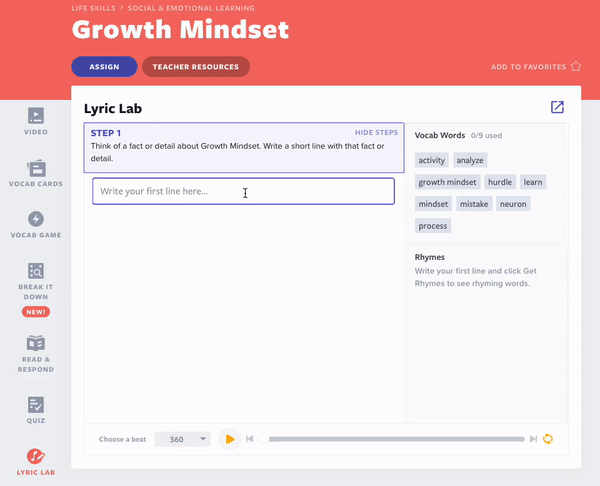
4. Don’t forget test prep
Each spring brings a flurry of test prep with state standardized testing on the horizon. To practice, consider creating Flocabulary Mixes that can be used in rotation stations. First, determine which skills could use a bit of bolstering or reviewing among your students. Your Flocabulary Mix can pair a skill video—providing brief instruction on a comprehension skill—with a video text for students to use to practice that skill. Choose by grade level and skill, then combine with one of the recommended related video texts. Have small groups of students rotate between the stations to watch the videos and complete the assigned activities for added practice. Keep an eye on student data to see who might need a bit more support before testing begins.
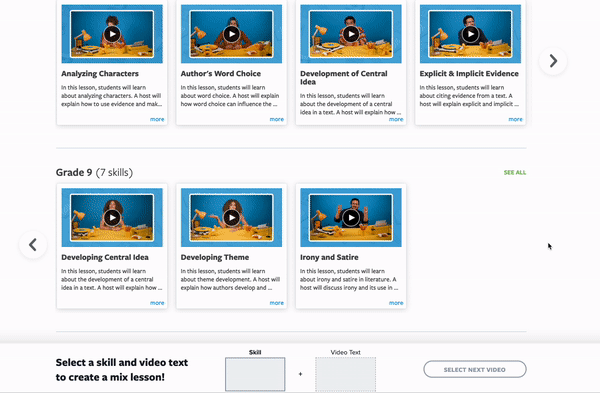
5. Utilize song lyrics for close reading
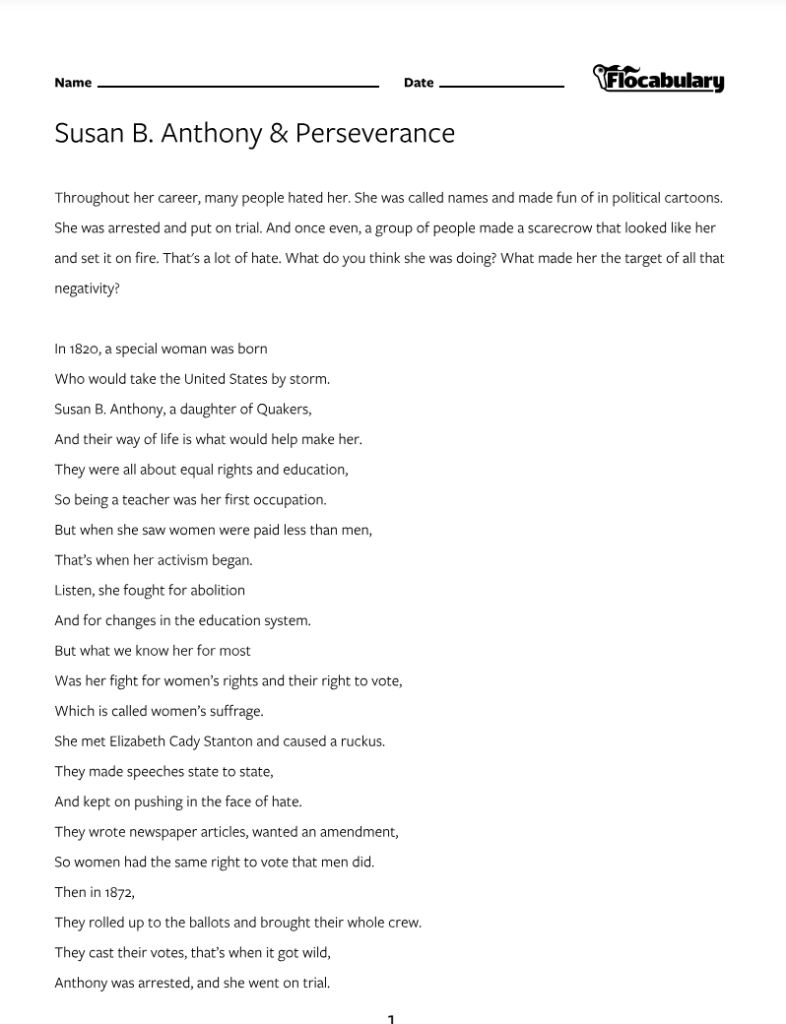
Mix up your daily reading period by adding some Flocabulary into the schedule. Did you know that each video has accompanying lyrics? Find them in the bottom left-hand corner below the video player. You may want to print out the lyrics, using the Handouts option under Teacher Resources, so that students can annotate the page as they work.
Use close reading strategies to preview the lyrics before watching the video and listening to the song. You may want to highlight and preview some of the key vocabulary in the verses. For repeated reading, as the song plays, have students follow along as they listen. After watching, listening, and reading, take some time to reflect on the piece as a group. Guide the discussion with pointed questions to challenge students’ higher-order thinking and solidify their comprehension of the piece.
6. Leverage insights for differentiation
You can review student vocabulary—exposure, practice, and proficiency—through your Flocabulary Teacher Dashboard*. This data at the individual and group level provides valuable insights as to how Flocabulary has impacted word exposure and word practice, as well as how students perform on vocabulary words across subjects, schools, grades, and classes. These insights then can inform your instruction strategies by earmarking where differentiation needs to occur to improve vocabulary acquisition. With a library of 1,300+ high-quality videos at your fingertips, you can assign different skills and a variety of vocab-rich content to your students. Not only that, additional Vocabulary Practice is available to each student, customized to their unique needs.
If you take a look at the Vocabulary Analytics tab within your Teacher Dashboard, you can determine how best to “Assign Vocabulary Practice” to individuals; they can complete these assignments in class or at home within their own accounts. The availability of such formative assessment tactics and next steps for differentiation—whether modifications or additional challenges—all within one authentically engaging and multimedia-rich platform makes for a turnkey solution.
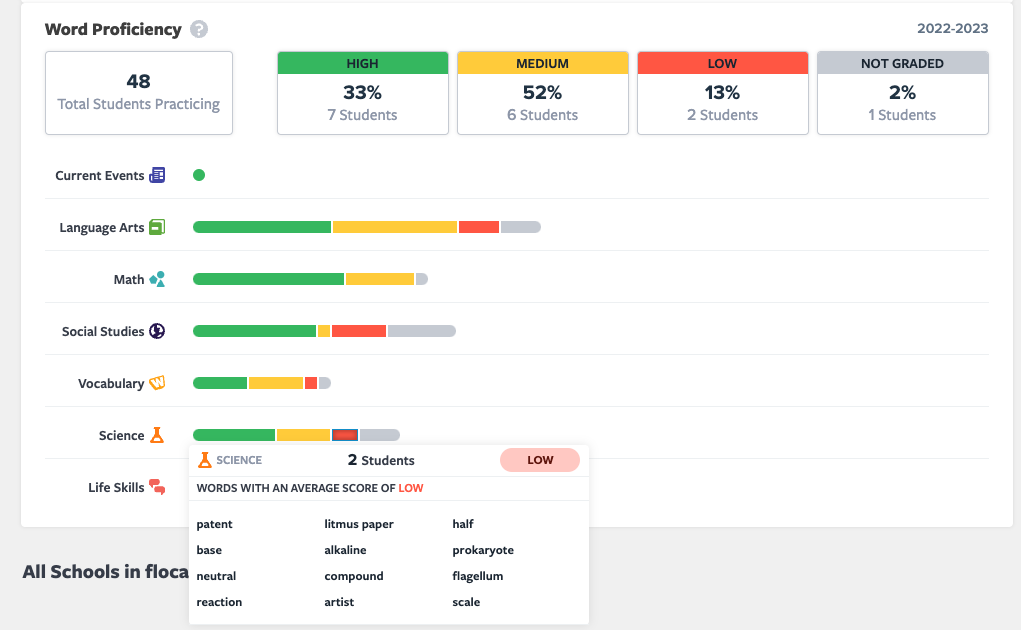
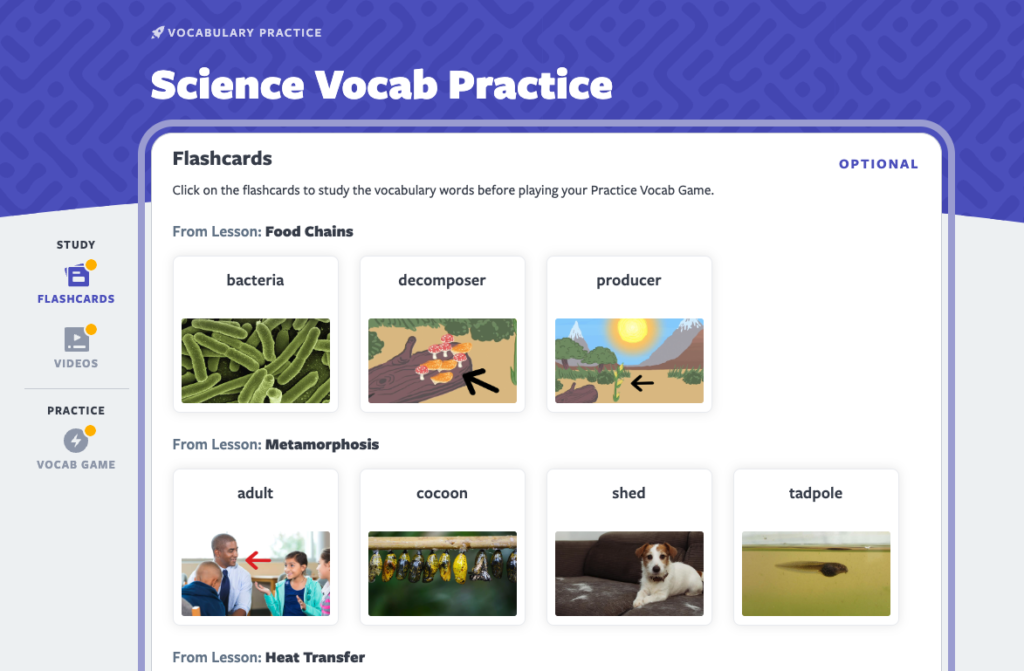
*To access the Analytics Dashboard, you must have a Flocabulary Plus school or district license. Get in touch with us to learn more about Flocabulary Plus.
7. Teach about current events
Open that planbook and mark time each Friday to visit the Week in Rap or Week in Rap Jr. section of Flocabulary. The Week in Rap is a weekly, rapped recap of important headlines and student news used for teaching current events. Choose between the Week in Rap or the Week in Rap Junior depending on your students’ age and maturity. Assign activities to students to collaborate on in class, or choose to have students complete activities at home as weekend assignments. The Week in Rap ties in well with social studies learning objectives. You may also want to use the videos as a way to bring morning journaling into your weekly schedule, giving students real-world issues to digest and weigh in on as they begin developing their own unique perspectives and opinions.
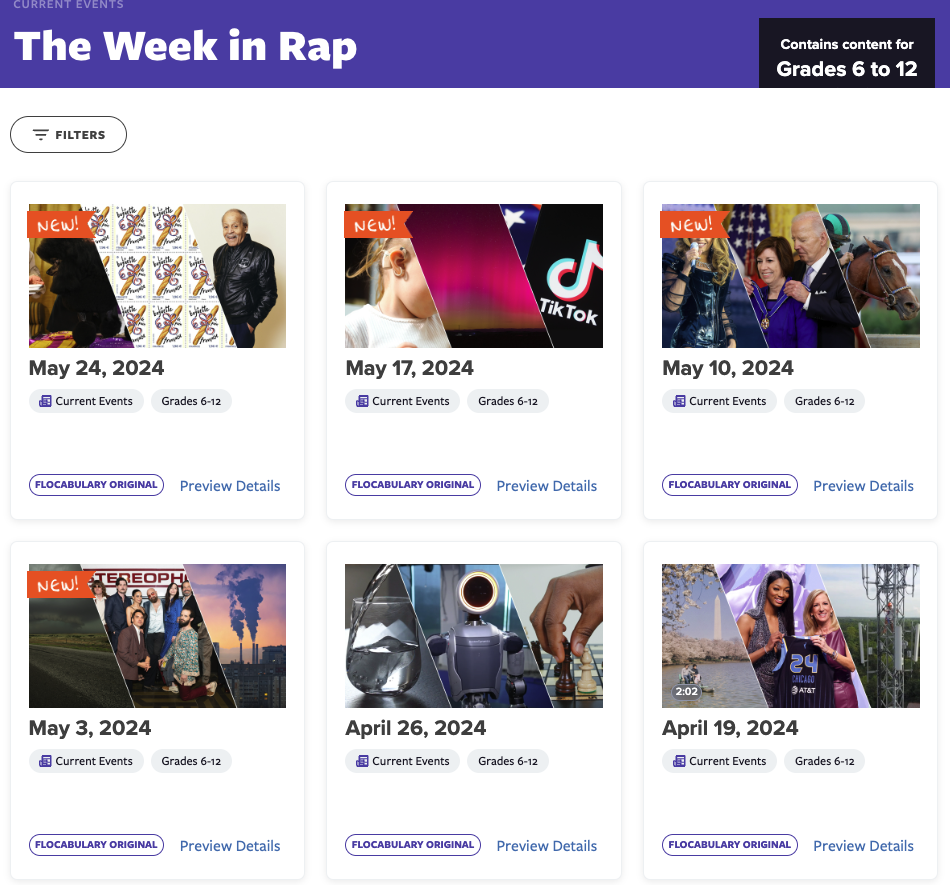
8. Activate Immersive Reader
Flocabulary is a truly inclusive resource that promotes culturally responsive teaching (CRT) through diverse content nested within the historical roots of hip-hop culture, with accessibility tools ensuring that all can benefit from such content. You can enable Microsoft’s Immersive Reader for an entire class or update individual profiles. Model how to use Immersive Reader and give all students time to explore this powerful tool that they can use on their own in the digital version of lessons’ lyrics, as well as in the Vocab Card, Read & Respond, Vocab Game, Quiz, Lyric Lab, and Break It Down activities. Immersive Reader can:
- Read text aloud and adjust the speed of the voice
- Adjust text size, font, and color
- Label the parts of speech
- View image references for words
- Translate words in a text or an entire block of text
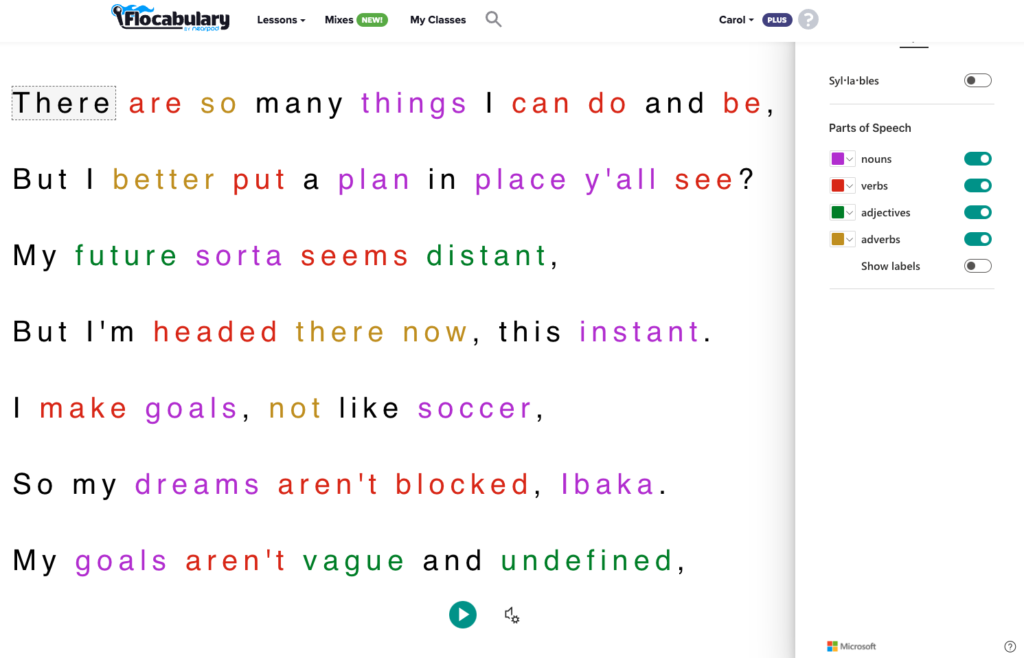
9. Provide additional practice
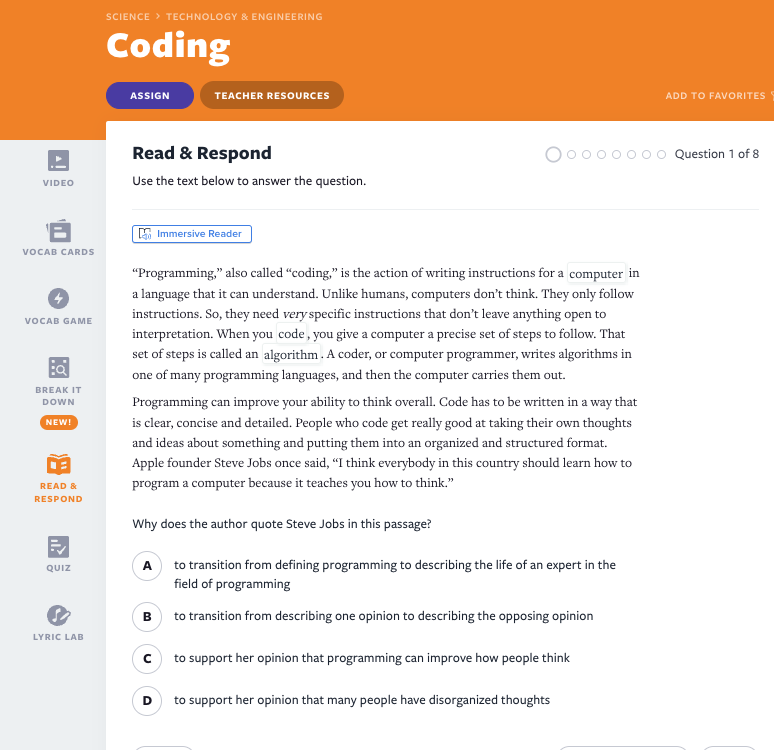
Don’t hesitate to reteach or provide additional practice to students who score below expectations. You can search for related content by subject, keyword search, or standards alignment and then share or assign an additional activity from a lesson’s six options: Vocab Cards, Vocab Game, Break It Down, Read & Respond, Lyric Lab, and Quiz. With Read & Respond, you will get a quick check for understanding when your student completes the series of multiple-choice questions. They receive answer feedback in the moment, and you can find individual scores in the Assignments section of your class. In addition, most lessons have an extra, printable activity in the Handouts section of the Teacher Resources. This printable activity typically provides a writing or creative opportunity for students to complete.
10. Build classroom culture
And don’t forget to showcase the innovative and creative work you and your students are doing in the classroom. Use Lyric Lab as an authentic assessment tool and ask students to “show what they know” in a creative space that wraps vocabulary acquisition and language learning in fun exercises. Use Lyric Lab to underscore what a safe, trusting, and encouraging classroom culture you have where students can support one another in sharing their voices—literally and figuratively. Lyric Lab creations can be shared as a recording or live, with or without instrumental beats. If your class is proud of their published work, consider inviting families to an after-school performance and showcase the many types of talent found in your classroom.
Start using Flocabulary in the classroom
By intentionally weaving Flocabulary into your classroom and across the curriculum, you’ll provide your students with enthusiastic and memorable learning experiences. You’ll provide the rigor and curiosity alongside the joy and fun! You’ll engage a classroom of learners who have diverse needs and varied interests with a library of high-quality and authentically engaging video lessons.
New to Flocabulary? Teachers can sign up for a trial to access our lesson videos and assessment activities. Administrators can get in touch with us to learn more about unlocking the full power of Flocabulary through Flocabulary Plus.
- SEO Powered Content & PR Distribution. Get Amplified Today.
- PlatoData.Network Vertical Generative Ai. Empower Yourself. Access Here.
- PlatoAiStream. Web3 Intelligence. Knowledge Amplified. Access Here.
- PlatoESG. Carbon, CleanTech, Energy, Environment, Solar, Waste Management. Access Here.
- PlatoHealth. Biotech and Clinical Trials Intelligence. Access Here.
- Source: https://blog.flocabulary.com/10-best-practices-implementing-flocabulary-in-your-classroom/



